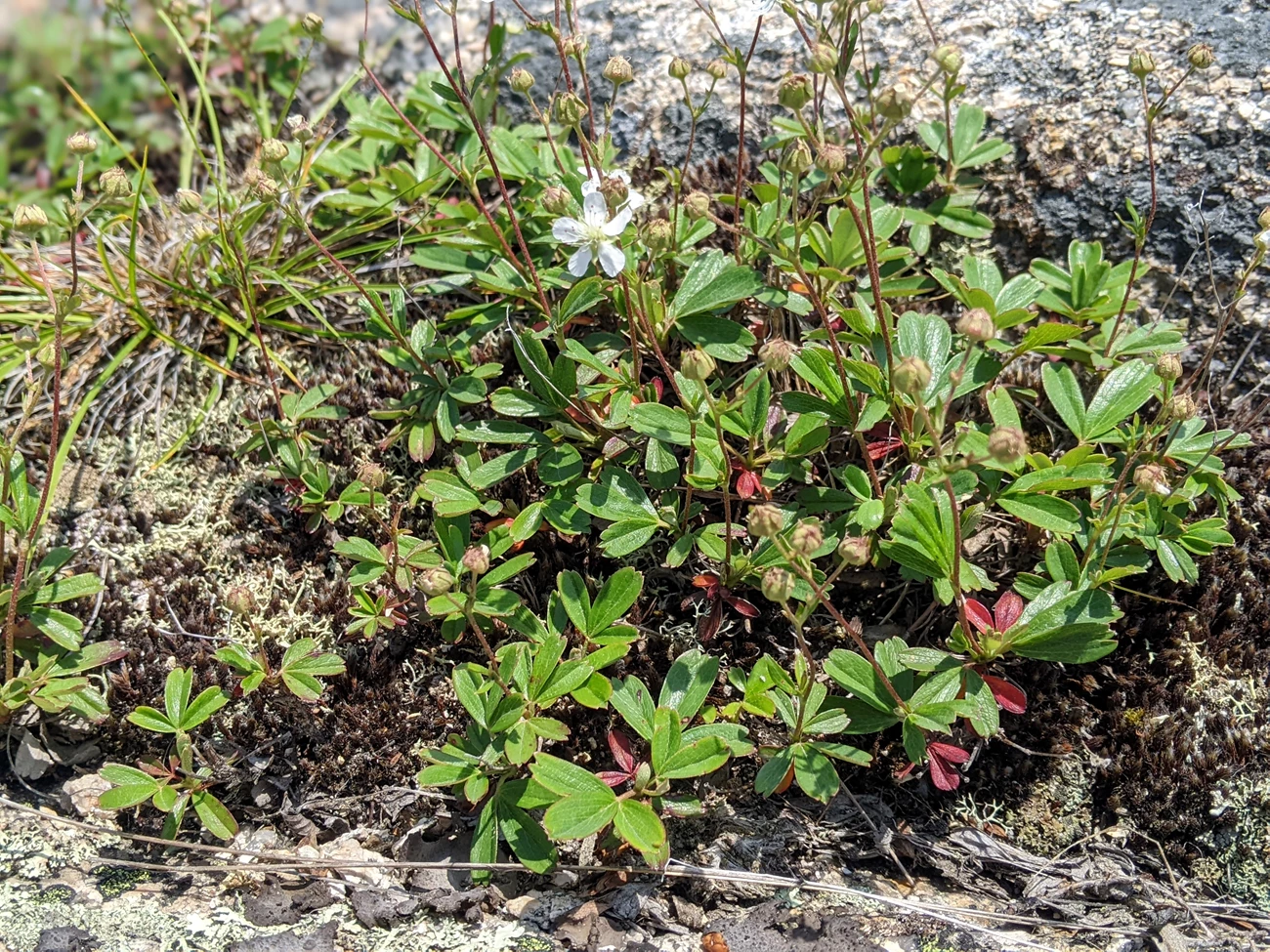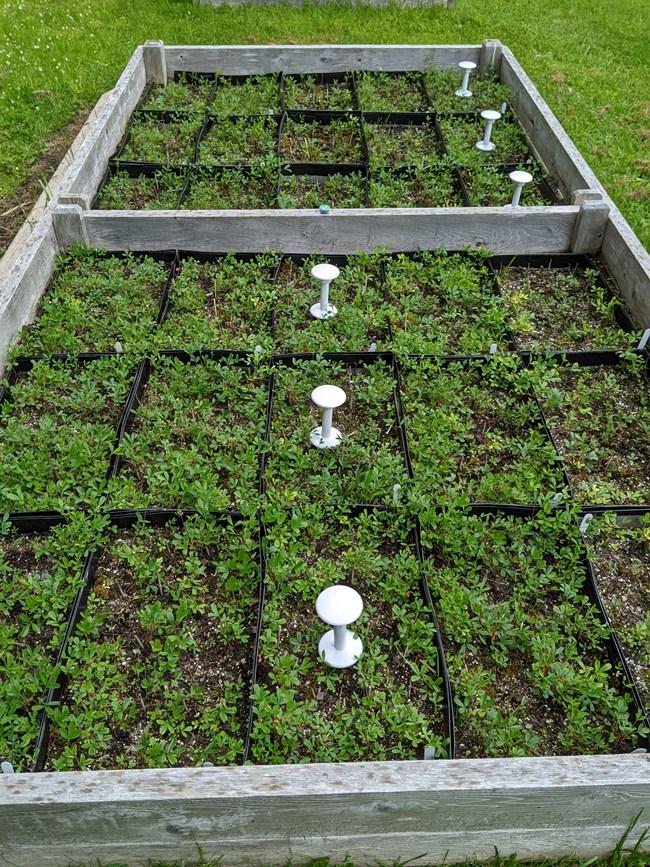Last updated: March 23, 2023
Article
Learning How to Restore Mountain Summits

NPS / Emma Forthofer

Photo by Chris Nadeau
The mountains of northeastern North America are an inspiring landscape with rocky summits that provide 360-degree views. Millions of people visit every year to take in the sights and appreciate their own place in this three-dimensional world (over half a million visited Acadia National Park’s highest peak, Cadillac Mountain, in 2021). For decades, some of our boot-clad feet have trampled the low plants that grow in thin soils on these rocky domes. With the loss of plants comes the loss of soil that would be held in place by their roots. Many of the most popular summits, though beautiful, are degraded.
How do you restore vegetation on a mountain summit? Chris Nadeau is looking for an answer on Cadillac. He’s an ecologist at Northeastern University and his expertise in the science of adapting to climate change is well suited to the question. That’s because northeastern peaks, like mountains worldwide, are experiencing rapid climate change. Analysis by the University of Maine’s Climate Change Institute shows that along Maine’s coast, which includes Acadia’s mountains, temperatures are increasing, rainfall is coming in more intense storms, and winter snowpack is declining and becoming more variable.
Restoring plants on a summit often involves carrying soil uphill, sowing seeds or planting seedlings, installing berms to limit erosion, and removing weeds. On Cadillac, a host of volunteers and staff from the park and its partners (Friends of Acadia, Schoodic Institute, and Native Plant Trust) have labored for years to re-plant some of the exposed granite. Given the effort and expense, they want some assurance that the plant community they establish can persist in whatever new climate prevails in coming decades. To get that assurance, Chris is conducting an experiment to see if a common but rarely examined strategy in restoration is effective.
Many scientists and restoration practitioners think that the best strategy is to bring in plants from many different populations, including ones from warmer locations. There’s a good theoretical basis for this. Sourcing plants from many places should increase genetic diversity and hence the chance that at least some will survive the vagaries of nature. And plants from areas that are warmer today should be better adapted to survive a warmer future. The strategy is being applied to many habitats worldwide from seagrass beds to prairies to oak forests.
But Chris says this approach has not been tested rigorously. “Does increasing genetic variation and bringing warm adapted individuals make that population more resilient to climate change? In theory, yeah. Great idea. But we don't know if it works.”
In the face of that uncertainty, Chris sees an opportunity. “We should be turning those restorations into experiments.” To that end, he is using three experimental garden beds that were installed in 2014 at different elevations in Acadia and have been used by many scientists. One bed is near the 1,527-foot summit of Cadillac Mountain. Another is at the mountain’s base, at about 350 feet elevation. It’s about 2°C warmer than the summit and represents the summit’s future. The third is near sea level on the Schoodic Peninsula, which is bathed in damp air coming off the Gulf of Maine. It’s about 3°C cooler than the summit, and a benign location where plants grow well. Scientists often use elevational gradients because they can study the effects of climate change directly without having to wait years.

Photo by Chris Nadeau
Hiking for Science
I met with Chris on a June morning to visit the experimental beds. He’s an affable scientist who patiently and happily explains his project, which he calls “Sustainable Summits,” to anyone who’s interested. (He even recorded brief videos -external on YouTube- from most of the 31 peaks he climbed when collecting source plants. He suspects it was mostly his mom who followed his adventures in real time.)
For his experiment, Chris collected plants from dozens of sites across New England (with permission from the owners and public land managers). Collecting 100 plants from each source population was no easy feat. In fact, Chris’s feet carried him over 60 miles of trails and up and down about 3 miles of elevation. He described his typical day: “I get up at six o'clock in the morning. I drive an hour or two to a mountain. I hike up and collect a hundred plants. I bring them down. I eat my lunch in the car while I drive to the next mountain. I hike up that mountain in the afternoon. I collect a hundred plants and bring them down. I stay in a hotel. Then I do it all again the next day.”
That went on for five weeks, interspersed with trips to Acadia to install his plants in the gardens. I felt breathless just hearing about all this activity, but I asked him if he enjoyed collecting. He laughed. “I got paid to be out hiking some of the most beautiful places in new England. And yes, it was also exhausting.”

NPS / Tim Watkins
Experimenting on a Mountain
The experiment’s subject is the three-toothed cinquefoil, Sibbaldiopsis tridentata, a common low-growing plant of northeastern rocky summits and shorelines. Like strawberries and spider plants, it sends out stolons – horizontal above-ground stems that sprout roots and shoots and establish new leafy plants where they touch the ground. Because of this growth habit, cinquefoil spreads across a patch and helps stabilize soil, allowing other plants to take root. If you want to understand how to restore an entire plant community, it’s a good species to focus on. Furthermore, climate change modeling by Dr. Jenny Smetzer suggests that over 90% of three-toothed cinquefoil’s current range in Maine will become unsuitably hot in the future. Figuring out how to help cinquefoil thrive on summits now and in the future is key to restoring these habitats.

NPS / Tim Watkins
Each of the experimental beds is about 8 feet by 12 feet in size and divided into 30 identical rectangular sections. To start the experiment, Chris planted 20 individuals in each section. In ten sections, he installed plants that he collected locally on Cadillac. Long-standing practice in restoration is to use local plants, so these sections represent a control against which to compare other treatments. In ten other sections Chris planted individuals that he collected from multiple peaks around the region with climates similar to Cadillac’s. Those sections contain more genetic diversity than the controls but are not adapted specifically to warmer conditions. And in the remaining sections he planted individuals from warmer locations – that is, places where plants are adapted to temperatures that Cadillac is expected to experience in the future.
Chris installed sensors to record light intensity, air and soil temperature, and soil moisture. He regularly removed weeds. At the park’s insistence, he cut off flowers on the plants so that genes from far away populations would not enter the park via his experiment. Then he let everything grow and monitored the gardens’ progress.

NPS / Tim Watkins
To keep track of plant growth, Chris periodically takes a photograph of each section from directly above. Software counts the proportion of green pixels in the photograph, which tells him how much the plants are spreading across the soil. As he puts it, “We think the more cinquefoil there is, the more roots there are and the better they are able to hold the soil on the mountain. That's kind of the ecosystem function that we hope cinquefoil will play.”
And what does he expect? Chris explains that per the recommended adaptation strategy “plots where we've increased genetic diversity should have more cover than plots where we haven’t.” And at the base of Cadillac, where it’s comparatively warm and dry, “the prediction is that plots that have plants from warmer locations will do much better.”
I asked him if he had any results yet, and he chuckled. “We're not seeing any differences among the treatments yet. Last year was just really good weather, and so all the plants just did great. This year, if we see a drought and especially a hot drought, then that's when we might see differences. So we need to monitor this for at least this year, and probably next year.” So the experiment is still underway and meaningful results will come later. It’s a wait, but not knowing the outcome in advance is part of the joy of science.
But whatever happens in the end, the results will inform effective, practical, and affordable restoration practices on Cadillac and elsewhere. And that’s the important point – managing and restoring habitats in the face of climate change requires good science that can tell you where to focus your efforts. Chris and his colleagues at the park and partner organizations are emphasizing experimentation in a profession that needs it as the world moves into a future we have never experienced in our history.
Even as his plants grow this season, Chris is thinking about future experiments at Acadia. He wants to understand the effectiveness of other methods like adding mosses and lichens to retain soil moisture during droughts, as well as ecological factors like competition among species and the role of climate “coolspots” on the landscape. Such considerations make the garden plots more realistic than what he has studied to date and may provide scientists and practitioners with more tools to ensure successful restoration in a changing climate.
As Chris notes, “Acadia is kind of leading the way on how we can restore those rocky bald mountain summits.” Given that, I expect there will be more experimental restoration projects to visit in the park over the years to come.
